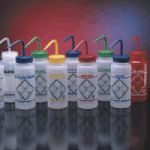Here are a few tricks that seem to work also;
Treat fuel in fuel tank as you normally would, run engine(s) afterwards.
*Remove fuel filter cartridges, empty into a safe container. Re-fill cartridge with a heavy mixture of fuel/stabilizer, re-install, and fire engine for the last time, of which may include your fogging procedure.
(add oil for FI engines where we can't fog in the normal sense)
or....... if you do not want to do this to the cartridge........
*Shut fuel off, run engines for your fogging procedure, followed by adding heavy stablized fuel mixture directly to carburetor fuel bowl (see squirt bottle below).
Either way, we end up with a more stabil-rich mixture in the carburetor.
I use a squirt bottle, something very similar to these, but one chemically specific for gasoline use.
With your finger over the air hole, you can squeeze and direct your mixture into the carburetor vent.
(I find myself doing this again (December & February), simply to keep them from evaporating.)
These also work great come spring time when we fire up an engine who's carburetor may have undergone some evaporation.
Batteries and Starter Motors love you when you do this!
 Great primer tool!
Great primer tool!
Be careful where/how you store one with fuel in it.
.................... or shut off the engines while fogging and leave the gas in the bowls.......
You mention a key point here that many do not consider.
I think that it is important that
WE kill the ignition while we continue to fog!
Do this, and you remove combustion for the last few revolutions.
If need be, have a helper do this while you continue to fog!
Remember that a dual plane intake must be fogged equally, or you leave some cylinders not as protected.
.


